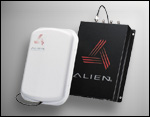EPC Class 1 pioneer Alien Technology has launched the latest version of its EPC Class 1-compliant RFID reader, saying that the latest model brings significantly improved performance.
The new ALR 9780 replaces the company’s first Class 1 reader, the ALR 9750, released last year. The new model, which is available immediately, boasts a faster processor, twice the number of antenna ports and faster read capabilities. Other companies that offer readers capable of reading EPC Class 1 tags include ThingMagic, AWID, SAMSys Technologies, Symbol Technologies and Intermec Technologies.
“The 9780 can read a single tag 350 to 400 times a second, that’s between 30 and 40 percent faster than our existing reader,” said Tom Pounds, vice president of corporate development and product strategy at Morgan Hill, Calif.-based Alien.
Like Alien’s previous reader, the new unit has the ability to turn off tags that have already been read. This feature speeds the throughput because a tag will be read just once in each pass through a portal. The new reader also doubles the number of ports for read-write antennas to four and has an additional new feature that allows the FCC-defined maximum signal strength of 1 watt to be delivered to each antenna attached to the reader, providing greater flexibility in how far antennas can be placed away from the reader.
According to the company, although its previous reader delivered 1 watt of power to each port on the reader, energy was lost along the connecting cable to the antenna, thereby weakening the sensitivity of the antenna. That loss was at a rate of about 0.25 decibel per meter of cable. “The older model was set up for a 2-meter-long standard antenna cable. That could mean a few decibels loss of signal strength if an antenna cable was run around a dock door,” says Pounds.
With the new reader, that standard length has been increased to 20 feet (6.09 meters), and the signal on each port can now be adjusted by an engineer using software tools to tune that signal up or down according to the length of the cable connection between the reader and each antenna, up to a distance of 30 feet (9.1 meters). That software also allows engineers to control other configuration options via either a serial port or a LAN interface. These options include configurable first-pass buffering and filtering modes and the ability to trigger reads by external event, command or schedule.
The new reader is already FCC-certified for the 915 MHz ISM band. The company says that before it starts the process of having the reader certified for European use, it will wait for changes in European regulations that will allow the reader 1-watt output. Those changes are expected in the third quarter this year.
Priced at $1,995, the new reader costs $200 more than the model it replaces, and it is currently available in production quantities in the United States.
Earlier this week, Alien also announced that due to an unexpected rise in demand for its EPC Class 1 UHF tags, the company plans to begin RFID tag assembly, testing and distribution at a leased facility in Fargo, N.D. The selection of the leased facility location has yet to determined, but the company says it will hire up to 30 people within the next 90 days. Last year, Alien announced it would build a manufacturing site in the North Dakota State University Research and Technology Park, in Fargo, but that plant would not have been operational until early 2005. Alien says it will now delay the construction of its new plant and does not expect the new plant to begin operation until early 2006. Until then, Alien will use the leased facility to assemble its tags.
Attend RFID Journal Live! 2004
Executive Conference, Chicago, March 29 to 31
It’s Where RFID Is Happening
Register Today


